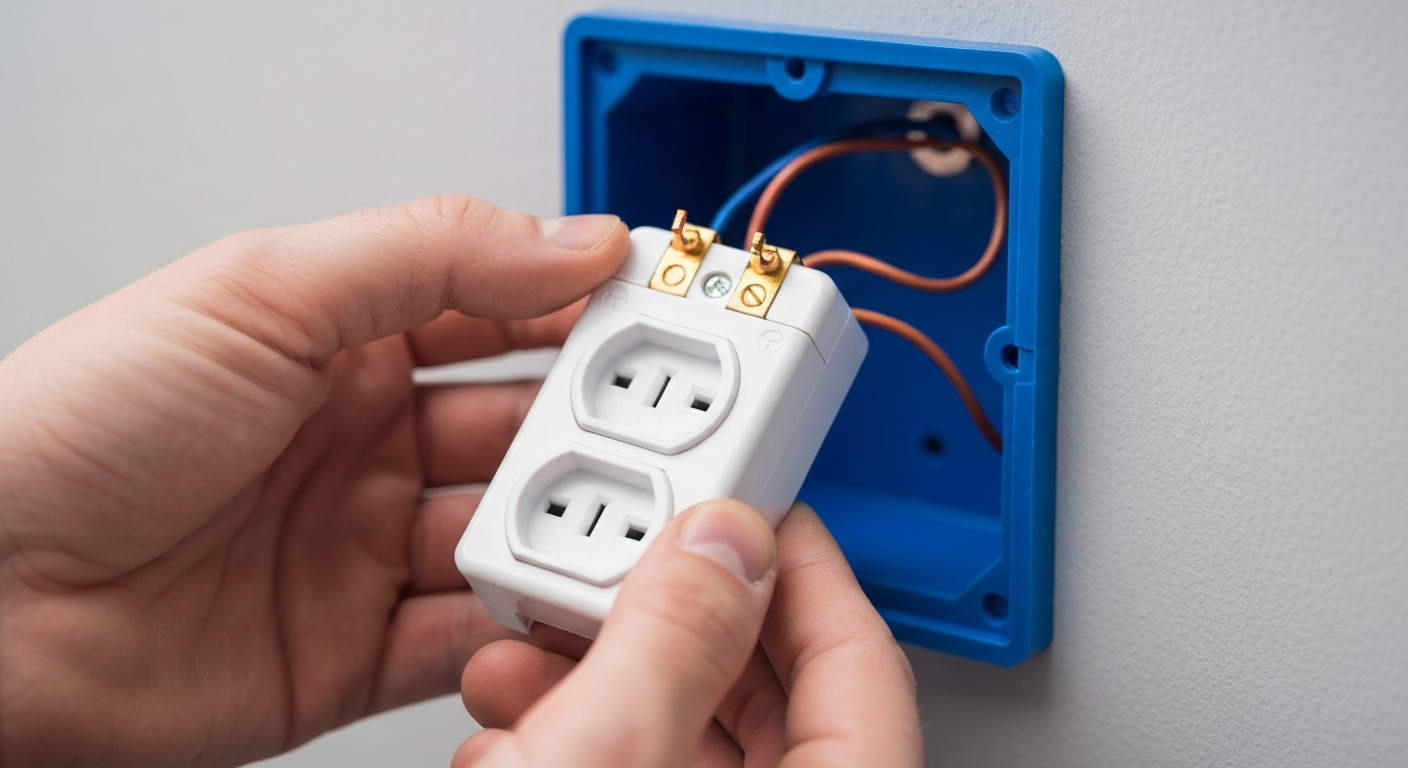
Receptacle vs Outlet: What the 2023 NEC Really Says
The 2023 NEC updates make this distinction more important than ever, influencing everything from GFCI protection to kitchen layouts. Let’s settle the debate and explore why getting this right is crucial for every modern electrician.
Back to Basics: The Official Definitions from NEC Article 100
To end the confusion, we have to go straight to the source: NEC Article 100, which provides the foundational definitions for the entire codebook. The difference between a receptacle and an outlet is clear, and it hinges on one being a *point* and the other being a *device*.
What is an Outlet?
According to the NEC, an Outlet is “A point on the wiring system at which current is taken to supply utilization equipment.”
Think of an outlet as a location or a point of access on a branch circuit. It’s the end of the line where you’ve planned for electricity to be used. This can be a box in the wall for a light fixture, a connection point for a hardwired dishwasher, or the box where you install a receptacle. This is why we have terms like a lighting outlet or a receptacle outlet—the term describes the outlet’s intended purpose.
What is a Receptacle?
The NEC defines a Receptacle as “A contact device installed at the outlet for the connection of an attachment plug.”
A receptacle is the actual wiring device that you physically plug a cord into. It has slots or contacts designed to accept a plug. So, while a receptacle is always installed *at* an outlet, the outlet is the point on the circuit where the device is installed. A key takeaway is that receptacles are covered specifically in Article 406 of the NEC.
The simplest way to remember it is: a receptacle is a type of device installed at an outlet, but not all outlets are for receptacles. A hardwired smoke detector is connected at an outlet, but there is no receptacle to plug into.
Why This Distinction Is Critical Under the 2023 NEC
Understanding these definitions is key to correctly interpreting some of the most significant changes in the 2023 NEC. These updates directly impact residential and commercial installations, making precise language essential for compliance.
Expanded GFCI and AFCI Requirements
The 2023 code cycle continues to expand requirements for both Ground-Fault Circuit-Interrupter (GFCI) and Arc-Fault Circuit-Interrupter (AFCI) protection. The code often uses the word “receptacle” specifically. For instance, in Section 210.8(A), the rules for kitchens were updated. The 2020 NEC’s Section 210.8(A)(6) specified GFCI protection for receptacles installed to serve countertop surfaces. The 2023 NEC revises this by removing the phrase “where the receptacles are installed to serve the countertop surfaces,” thereby expanding GFCI requirements to nearly all 125-volt through 250-volt receptacles in the kitchen. Additionally, a new section, 210.8(A)(7), was added to require GFCI protection in areas with a sink and permanent provisions for food or beverage preparation, such as a pantry or wet bar, regardless of their distance from the sink. Similarly, AFCI protection, governed by Section 210.12, is required for outlets in specific dwelling unit locations to mitigate fire hazards from arc-faults. This precision ensures that safety measures are applied exactly where they’re needed most, and understanding these AFCI requirements and GFCI rules starts with knowing what a receptacle is.
The Kitchen Island Receptacle Outlet Rules
One of the most talked-about changes in the 2023 NEC is in Section 210.52(C), which addresses receptacle outlets on kitchen islands and peninsulas. Previously, at least one receptacle outlet was mandatory. Now, installing one is optional. However, the code is extremely specific: if you *do* install a receptacle, it can no longer be mounted below the countertop. This change directly uses the term “receptacle outlet,” highlighting a specific type of outlet that must follow precise placement rules to prevent cord-related hazards. This demonstrates how the NEC uses its own definitions to create enforceable, clear-cut rules.
Impact on Load Calculations and Box Fill
The distinction is also vital for planning and installation. When performing load calculations for a branch circuit, knowing whether an outlet is for a specific, hardwired appliance versus a general-use receptacle outlet changes the calculation. Likewise, for box fill calculations, a simple lighting outlet has different requirements than a box containing a bulky, modern wiring device like a GFCI or smart receptacle. Getting these calculations right from the start is fundamental, and a misunderstanding of the outlet’s purpose can lead to code violations. For a deeper dive, it’s helpful to review how to properly calculate junction box size based on NEC standards.
A Market Driven by Safety and Innovation
The focus on specific wiring devices is also reflected in the broader industry. The global market for wiring devices is booming, driven by an increasing demand for enhanced safety and smart technology. We’re seeing rapid growth in specific categories:
- Tamper-Resistant Receptacles (TRRs): Now standard in most areas of new construction, TRRs feature an internal shutter system to prevent the insertion of foreign objects. The market for these devices is projected to grow from $0.77 billion in 2025 to $1.11 billion by 2033, reflecting a permanent shift towards child safety.
- Weather-Resistant Receptacles (WRRs): Essential for outdoor and damp locations, these receptacles are built with UV-resistant materials and corrosion-resistant components to withstand the elements, ensuring long-term safety and code compliance.
- GFCI Receptacles: With expanding NEC requirements, the global market for GFCI receptacles is projected to reach $3.5 billion by 2030. This growth underscores the industry’s commitment to preventing electrical shock hazards.
Stay Current, Stay Compliant
The “receptacle vs outlet” debate is more than just a matter of trade jargon. It’s a clear example of how the NEC uses precise language to build a framework for safe and effective electrical systems. As the code evolves, so must our understanding of its foundational concepts. Keeping up with changes, like understanding how the 2023 NEC updates impedance grounding, is what separates a good electrician from a great one.
By mastering the language of the code, you demonstrate your expertise, ensure every installation is compliant, and build trust with clients and inspectors alike. Ready to sharpen your code knowledge and stay ahead of the curve? Browse our courses to find state-approved continuing education that keeps you at the top of your game.
Frequently Asked Questions
- Is a hardwired light fixture an outlet?
- Not exactly. The light fixture is the utilization equipment. The box in the ceiling where it is connected to the branch circuit is the lighting outlet. This is a perfect example of an outlet that is not a receptacle.
- What does the NEC mean by “utilization equipment”?
- Defined in NEC Article 100, utilization equipment is simply the equipment that uses electrical energy for purposes like producing light, heat, or mechanical motion. This includes everything from a lamp and a toaster to a motor or an HVAC unit.
Disclaimer: The information provided in this educational content has been prepared with care to reflect current regulatory requirements for continuing education. However, licensing rules and regulations can vary by state and are subject to change. While we strive for accuracy, ExpertCE cannot guarantee that all details are complete or up to date at the time of reading. For the most current and authoritative information, always refer directly to your state’s official licensing board or regulatory agency.



